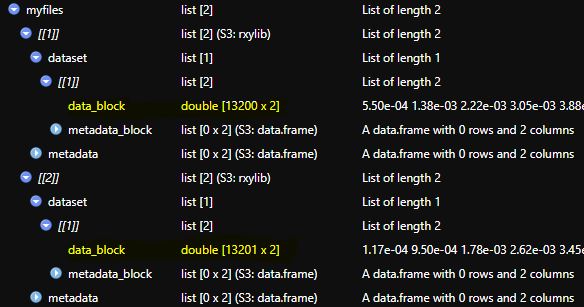Dear @nirgrahamuk @dromano @hendrikvanb,
following yours indication I paste here an example of the dataset:
myfiles<-list(structure(list(dataset = structure(list(list(data_block = structure(c(0.00055,
0.001383333, 0.002216667, 0.00305, 0.003883333, 0.004716667,
0.00555, 0.006383333, 0.007216667, 0.00805, 0.008883333, 0.009716667,
0.01055, 0.011383333, 0.012216667, 0.01305, 0.013883333, 0.014716667,
0.01555, 0.016383333, 0.017216667, 0.01805, 0.018883333, 0.019716667,
0.02055, 0.021383333, 0.022216667, 0.02305, 0.023883333, 0.024716667,
0.02555, 0.026383333, 0.027216667, 0.02805, 37694, 37700, 37701,
37662, 37672, 37671, 37690, 37684, 37731, 37739, 37721, 37682,
37735, 37756, 37746, 37708, 37753, 37746, 37754, 37722, 37734,
37721, 37680, 37685, 37717, 37718, 37696, 37653, 37664, 37661,
37638, 37680, 37729, 37749), .Dim = c(34L, 2L), .Dimnames = list(
NULL, c("V1", "V2"))), metadata_block = structure(list(key = character(0),
value = character(0)), class = "data.frame", row.names = integer(0)))), .Names = ""),
metadata = structure(list(key = character(0), value = character(0)), class = "data.frame", row.names = integer(0))), format_name = "SPECS SpecsLab2 xy", class = "rxylib"),
structure(list(dataset = structure(list(list(data_block = structure(c(0.000117,
0.00095, 0.001783333, 0.002616667, 0.00345, 0.004283333,
0.005116667, 0.00595, 0.006783333, 0.007616667, 0.00845,
0.009283333, 0.010116667, 0.01095, 0.011783333, 0.012616667,
0.01345, 0.014283333, 0.015116667, 0.01595, 0.016783333,
0.017616667, 0.01845, 0.019283333, 0.020116667, 0.02095,
0.021783333, 0.022616667, 0.02345, 0.024283333, 0.025116667,
0.02595, 0.026783333, 0.027616667, 38494, 38502, 38463, 38426,
38411, 38436, 38424, 38360, 38296, 38264, 38216, 38191, 38205,
38212, 38194, 38128, 38127, 38122, 38127, 38104, 38066, 38005,
37926, 37865, 37915, 37941, 37910, 37877, 37875, 37902, 37868,
37832, 37875, 37837), .Dim = c(34L, 2L), .Dimnames = list(
NULL, c("V1", "V2"))), metadata_block = structure(list(
key = character(0), value = character(0)), class = "data.frame", row.names = integer(0)))), .Names = ""),
metadata = structure(list(key = character(0), value = character(0)), class = "data.frame", row.names = integer(0))), format_name = "SPECS SpecsLab2 xy", class = "rxylib"))
Unfortunately I could not solve the problem using your helpful suggestions; @hendrikvanb's approach provided me the following result:
[[1]]
NULL
[[2]]
NULL
while @nirgrahamuk code provided the following error:
processlist(myfiles)
Error in results_list[[l + 1]] <<- x[["data_block"]] :
object 'l' not found
I hope that now that the dataset is available here, it would be helpful for you. Thank you very much for your help and willingness!
